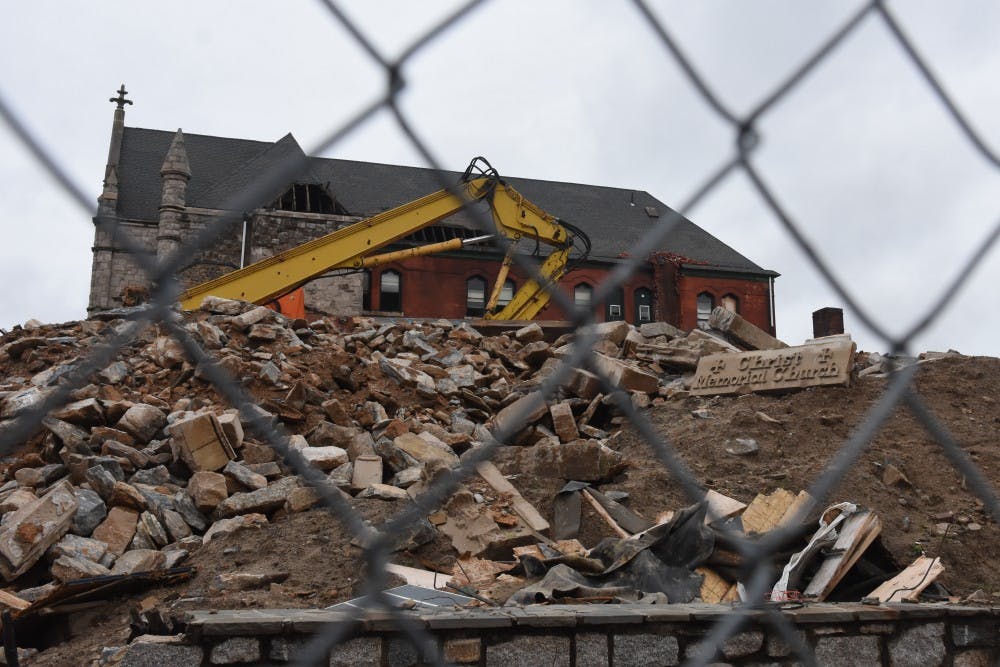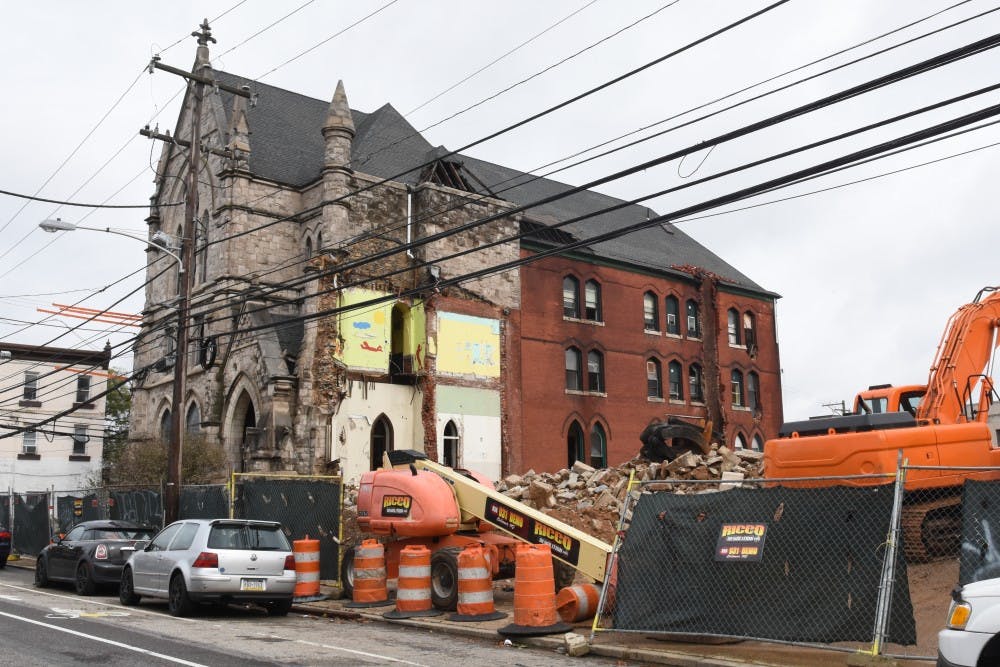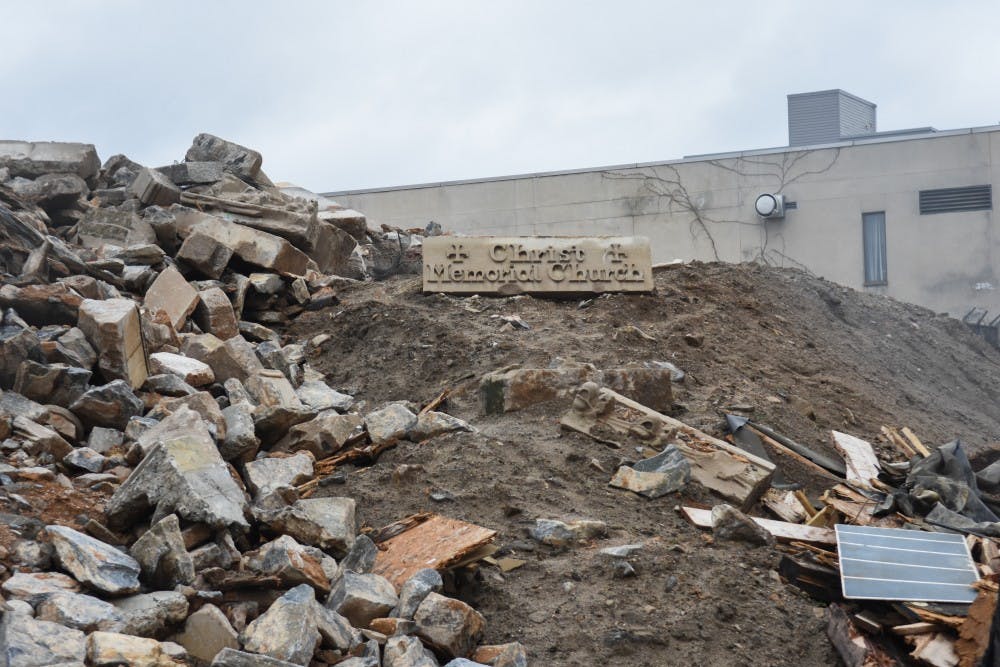
Once the epitome of West Philadelphia’s high-Victorian history, the 131-year-old church on 43rd and Chestnut streets has begun the process of its demolition — a fate local Philadelphia residents say is emblematic of a foreboding trend in historical neighborhoods near Penn's campus.
A cornerstone of the neighborhood, the property of the Christ Memorial Reformed Episcopal Church was sold to a New York-based company for more than $10 million in early June. The building's demolition permit was issued in April with the demolition process reportedly scheduled to begin in early May, but it is unclear whether it proceeded on schedule.
Although the church was damaged from a steeple collapse in a 2004 storm, the landmark still bore significance in the eyes of some local residents. Residents of the community consequently have pushed back, trying to stop the demolitions, to no avail.
In October 2017, the Preservation Alliance of Greater Philadelphia recruited 2016 School of Design graduate Amy Lambert and 2012 School of Design graduate Rachel Hildebrand to formally nominate Christ Memorial for an official historic designation.
From an architectural perspective, Lambert said, the building was structurally sound and could have been retrofitted to serve other purposes. But the demolition was announced before she and Hildebrand completed the nomination process.
“I still live in the neighborhood, so it’s been a landmark for me ever since I moved here, so it’s heartbreaking,” Lambert said. “It’s an especially acute loss because we were so close to saving it and turning in this nomination, so it hurts especially for so many reasons.”
Economic Ph.D. candidate Artem Kuriksha lives in an apartment complex across the street from Christ Memorial, and said he was sad to see the church demolished.
“When I chose an apartment for myself, [Christ Memorial] was a factor for me, I was expecting to see it in my window each morning," Kuriksha said. "But now it’s not here so for me, it’s just a sad surprise.”
Spruce Hill Zoning Director Barry Grossbach said he was also disheartened. Although he speculated restoration efforts could have been “prohibitively expensive,” Grossbach said the loss of the church has deeply affected some residents of the community, particularly those like Kuris who bought or rented property nearby.

Patrick Grossi, director for advocacy of the Preservation Alliance for Greater Philadelphia, said the decision to demolish Christ Memorial is a consequence of intensifying demand for housing, primarily generated by students.
He said he perceives that with an ever-expanding influx of undergraduate students and young professionals, there exists a strong profit motivation to replace historic buildings with more modern, space-efficient residential properties.
“West Philadelphia is changing,” Grossi said. “It’s perceived that there are greater incentives to tear down a building like [Christ Memorial] and construct something new for a lucrative housing project than there are to spend sweat equity and actual equity to repair a building like [Christ Memorial].”
He said the property deserved to be included on the Philadelphia Register of Historic Places and should not have been demolished.
University City resident Meg Robinson said she was similarly disappointed by the demolition of Christ Memorial, adding that she would miss the church's historic nature and unique architecture.
"One of the neat things about Philly is that we have a lot of historic buildings, and it seems a shame to lose one of them," Robinson said. "It's still a nice bit of architecture, whether you believe in one religion or the other."
Grossbach added that the supplanting of historic properties by newer residential buildings may have harmful effects on the neighborhood’s architectural quality. Local residents are given little input on certain developments, and Grossbach said there is a possibility the building that will go up where the church once stood will have a different architectural style, disconnecting it from the rest of the community.
"You [could] really have a pretty mundane, if not semi-ugly building just sitting there without any character and without any relationship to the neighborhood that it’s a part of," Grossbach said.
Lambert reiterated Grossbach's concerns, saying she feared new, modern construction projects could be too disjointed from the neighborhood's historic character.
“Historic buildings are being torn down, and large boxes that can accommodate large square-footages and get high rent are being put in,” Lambert said. “Nobody wants to put in the time or the effort to restore these buildings and try to fit them out in creative ways.”
Lambert acknowledged that some may not perceive architectural preservation as a pressing issue. She emphasized, however, that protecting historic architecture, like that of Christ Memorial, can help strengthen community identity and protect a people's legacy.
"Historic preservation suffers a little bit from an antiquated image and a thinking that it's only for rich elites, or rich white people, or folks in Rittenhouse, or Washington Square," Lambert said. "It's focused more and more on the heritage of everybody, telling everybody's story from a big-picture perspective."

The Daily Pennsylvanian is an independent, student-run newspaper. Please consider making a donation to support the coverage that shapes the University. Your generosity ensures a future of strong journalism at Penn.
Donate



